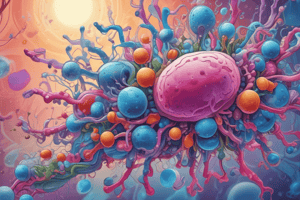Podcast
Questions and Answers
What is the genetic material of bacteria housed in?
What is the genetic material of bacteria housed in?
- A single-stranded RNA molecule
- A membrane-bound nucleus
- A double-stranded DNA helix
- A circular chromosome (correct)
What is the primary component of bacterial cell walls?
What is the primary component of bacterial cell walls?
- Lipopolysaccharide
- Chitin
- Cellulose
- Peptidoglycan (correct)
How do bacteria obtain energy through respiration?
How do bacteria obtain energy through respiration?
- By using carbon dioxide as the final electron acceptor
- By consuming glucose to produce energy
- By using oxygen as the final electron acceptor (correct)
- By utilizing sunlight to generate ATP
What process do bacteria use to carry out various metabolic processes?
What process do bacteria use to carry out various metabolic processes?
What is the main difference between Eubacteria and Archaebacteria?
What is the main difference between Eubacteria and Archaebacteria?
What distinguishes Mollicutes or Mycoplasma from Eubacteria and Archaebacteria?
What distinguishes Mollicutes or Mycoplasma from Eubacteria and Archaebacteria?
How do bacteria reproduce?
How do bacteria reproduce?
What is the function of plasmids in bacteria?
What is the function of plasmids in bacteria?
What is the genetic material structure in bacteria?
What is the genetic material structure in bacteria?
How does bacterial DNA replication differ from eukaryotic DNA replication?
How does bacterial DNA replication differ from eukaryotic DNA replication?
Study Notes
Bacteria: A Comprehensive Guide
Bacteria are single-celled microorganisms that play a crucial role in various industrial and ecological processes, including decomposition, fermentation, and nitrogen fixation. They are essential for life on Earth, and understanding their structure, reproduction, metabolism, classification, and genetics is crucial for their effective utilization and control.
Bacterial Structure
Bacteria are prokaryotic cells, meaning they lack a nucleus and other membrane-bound organelles. They have a simple, circular chromosome that contains the genetic material. Their cell walls are composed of peptidoglycan, a complex polymer of sugars and amino acids, and they have a thin layer of lipids called the cytoplasmic membrane.
Bacterial Reproduction
Bacterial reproduction occurs through binary fission, in which the chromosome is first replicated, and the cell then divides into two. This process is rapid, with some bacteria able to double in number every 20 minutes.
Bacterial Metabolism
Bacteria carry out various metabolic processes, including fermentation, respiration, and synthesis. They obtain energy through respiration, using oxygen as the final electron acceptor, and fermentation in the absence of oxygen. They also synthesize various compounds, such as enzymes and antibiotics, which are used in industry and medicine.
Bacterial Classification
Bacteria are classified based on their morphology, staining properties, and physiology. They are typically classified into three main groups: Eubacteria, which includes true bacteria that have a peptidoglycan cell wall; Archaebacteria, which includes organisms with a different type of cell wall and other unique characteristics; and Mollicutes or Mycoplasma, which are small, wall-less bacteria.
Bacterial Genetics
Bacterial genetics involves the study of the genetic material, its structure, and its function in the cell. Bacteria have a single, circular chromosome, and some species also have plasmids, which are small, circular pieces of DNA that can be transferred between bacteria. Bacteria use a unique form of DNA replication, which involves the use of single-stranded DNA as the template for new DNA synthesis.
In conclusion, bacteria are essential microorganisms with a wide range of applications in various industries and ecological processes. Understanding their structure, reproduction, metabolism, classification, and genetics is crucial for their effective utilization and control.
Studying That Suits You
Use AI to generate personalized quizzes and flashcards to suit your learning preferences.
Description
Test your knowledge about the structure, reproduction, metabolism, classification, and genetics of bacteria with this comprehensive quiz. Explore topics like bacterial cell structure, reproduction through binary fission, metabolic processes, classification based on morphology and physiology, and the unique genetics of bacteria.




